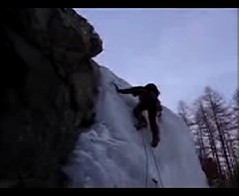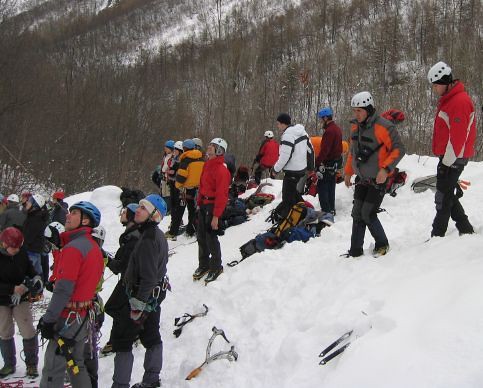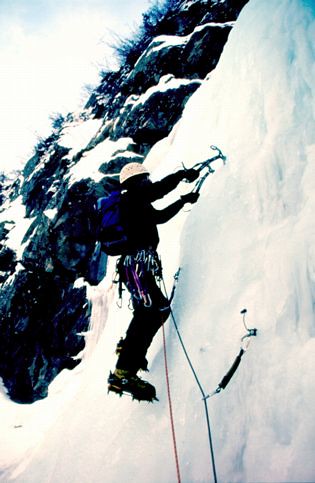By Simon Chandler & Nick Willis – March 2006
 |
| Fracastorus – a 5 pitch III/3+ 190 metre Glace en Cascade (click on any picture for larger image) |
I was struggling to second pitch 4 of “Fracastorus”. Will Gadd’s
book had been right – alternating leads when climbing ice is not
such a good idea. Having finished a lead you then have to stand
still for a long time while your second climbs up, you swap over
gear, then they lead the next pitch. In our desire to climb at the
sharp end Nick and I had spurned this advice, and now I was paying
the price. The temperature was actually relatively mild, but water
trickling down over the surface of the ice had made my gloves wet,
and my hands senseless with cold. My damp gloves were literally
freezing – sticking to the ice whenever they touched it. The cold
had got to me and I felt exhausted. At least, as I approached the
belay, I was starting to move less like a stiff-limbed zombie.
Nick suggested we leave pitch 5, but I said something stupid like
“I’ve not come this far to give up now”. Handing over the gear we
discussed how to do this last pitch. It all looked very steep, and
the bit nearest us was dripping with water. As I traversed past
this to reach the drier ice, water splashed into my face and down
my neck. Hmmm – refreshing?! At least now on the lead I was warming
up again.
ICE 2006 was a festival held in the Ecrins
region of the French Alps. A premier destination for climbers, it
has hosted the ice climbing festival for the past 15 years. It
seemed a great opportunity for us to attempt this aspect of
climbing amongst the more ‘ice experienced’ Europeans. The festival
was advertised as having free workshops for novice climbers, free
loan of equipment from gear manufacturers, and a free film festival
and entertainment in the evenings. We’d also arranged to share a
gite in L’Argentiere la Bessee with other ice climbers that we had
met through the internet Rock forums, hence an affordable yet
cosmopolitan base was formed with Conor, Nikolaus and Elsa. Your
man Conor also introduced us to his Irish climbing partners and a
very sociable circle added to the fun and fear of the climbing.
As the magazine articles constantly tell us, European ice falls are
so readily accessible with the advent of sleazy jet and
competitors, so why do we want to dodge Scottish weather when we
can climb blue ice cascades after a croissant breakfast? Clearly,
the Scottish experience will always be very different from that
encountered in the Alps and a direct comparison is a little unfair.
Bolted belays, twenty minute approaches and consistent weather
ensure our Euro cousins get more action each winter, and glossy
photos of axe wielding grimpers had certainly caught our attention.
Mervyn’s article from the March 2004 newsletter had enticed me to try this aspect
of the climbing game, and Jerry Gore’s article in a recent Summit
magazine (#40, winter 2005) had made it sound safe and almost
sane.
I was getting very tired. Halfway up the continuously steep pitch
was a slight flattening off. When this was level with my face I
used the adze of one axe to cut two large steps in it, then a few
moves later I was able to stand on these with my toes pointing
down, giving my calves a rest. What a relief. Whilst resting on
this makeshift ledge I put in another ice screw. My last. The belay
was in sight however – a loop of rope around a tree. One more push
and I’d be there. “Make it count” I said to myself as I swung my
axes. I’d been getting so tired that my left hand had lost
coordination, and many of the swings resulted in just a glancing
blow off the ice. In contrast the swing technique of my dominant
hand had been getting better and better. Combined with the soft wet
ice my right pick was often sticking first time with a reassuring
‘twang’ sound. I only needed to try again when the initial
impact caused the ice to break up. Sometimes this happened in an
obvious way – with a great chunk of ice falling away from under the
axe’s blow. At other times the axe went in, but it just didn’t feel
right. Just four days ago I’d never even worn a pair of crampons,
so how I knew this I really don’t know.
 |
| Click image to go to Flickr to play the movie |
We spent the first day of the festival having a free lesson in ice
climbing with a guide from Millet. A good tip is to make sure you
get to their stand at the expo as soon as possible on the opening
evening so that you can sign-up for the limited places. Our native
French gite-mate, Elsa, realized this and made sure that we were
all at the top of Millet’s list. The next morning we were bussed
out to Freissinieres valley for some top rope climbing on an ice
fall of varying steepness. It was the first time I’d even worn
crampons, so I started cautiously. The necessary technique was
practised and improved upon in this relatively safe environment,
and proved to be a perfect foundation for the rest of the week.
However, many people were crammed into this beginners sector and
problems arose due to the inviting nature of this ice fall. As a
consequence of our experiences in this sector and elsewhere during
the festival we sent a letter to the organisers via Jerry Gore, who agreed to help with translation. Our day with the Millet guides culminated in leading a single pitch on pre-placed protection. We were pleased with this rapid progress.
 |
| The Beginners Sector – as busy as Stanage on a Bank Holiday |
The next day we found a very small quiet section of ice and learnt
how to place gear ourselves; handling ice screws with one hand
whilst hanging from an ice axe with your other can be tricky, and
it was only after half a dozen failed attempts that we succeeded in
making Abalakov anchors quickly and effectively. We started this
practice standing on the ground, and worked our way up to creating a
new ‘micro route’. It was only 3m high, but was good training. This
day had been a physical rest, but was good technical and mental
preparation for our first ever multi-pitch lead on ice the
following day.
 |
| Nick’s first ice lead – Paulo Folie |
I heard Simon’s call signalling his safe arrival at the belay
point. My aim was to set off at speed, as a quick time check
revealed it was getting very late. We had avoided the cost of
hiring a car by using the free mini busses that were provided by
the festival for getting out to the frozen valleys. This had worked
well so far this week, but today the return connection now seemed
unlikely. I traversed through the dripping water to reach Simon’s
first ice screw, quickly spinning it out from the cascading ice.
We were both particularly cautious when placing and removing the
screws, always reminding ourselves this was mostly borrowed kit. A
clumsy drop could cost us forty quid! Fortunately, nothing was
dropped and even we stayed connected to the ice throughout. A fall
on the first day by one of our Irish gite-mates on lead had been a
shock, but it had proved the reliability of modern ice screws. It
held perfectly whilst Conor claimed a very early ice-lob – the
festival hadn’t yet officially started; we were mightily impressed
by the boldness of these honorary IMCers – The Irish
Mountaineering Council!
 |
| Starting the last pitch of Fracastorus |
Back on pitch 5 of Fracastorus, I kicked and swung the line Simon
had led previously, noting that it was the steepest pitch and
clearly the crux of the route. Joining Simon at the sturdy looking
tree, I told him we’d be struggling to make the bus due to the
late time. However, Simon was already focused on arranging the
anchors and rope, organising the gear ready for the multi-pitch
abseil which was the descent method for this III/3+ 190 metre
route. We were physically and mentally drained and the temperature
was noticeably dropping on this North facing fall, yet we still had
to get down and the seriousness of the situation certainly made us
cautious with the rope work. We talked through everything that we
were doing in setting up the first abseil so that the other could
double check and no silly mistakes were made.
Simon set off first, manoeuvring the ice bulges in reverse whilst I
shivered into my belay jacket and swapped wet gloves for a semi-dry
pair. Several metres below me, he came to a stop and had to adjust
his backup French prussic; the ropes were freezing-up and the
clumping ice was jamming in the prussic which required Simon to
drop a turn. Meanwhile, I forced myself to relax and take in the
sights from the tree, the light was slowly ebbing away but
Fressinieres Valley was still in clear view as I stamped my plastic
clad feet and willed warm blood back into my fingers. In four days
we had experienced just a tiny section of this beautiful winter
scene, yet there was still the Valleys of Fournel and Celiac
playing on my mental wish-list, Glace et mixte en cascade.
By the time we reached our bags it was 6.10pm. We’d missed the last
bus home and it was dark, so it was on with our head-torches and
rucksacks, and – with our crampons still on – we set off down the
40 degree snow slope back to the bottom of the valley. The car park
was empty, but we managed to hitch a ride back the 5km to
L’Argentiere la Bessee with a kind French family. In fact, they
had initially said they had no room to give us a lift. A fair
point really – they were two adults, two kids and a dog! On
realising we had no other means of getting back, they took pity on
our exhausted faces and the minus 10 environment. After much
shuffling and rearranging we crammed ourselves into the car. I
left Simon to politely converse in French from the boot, whilst I
cursed my laziness with foreign languages. Next time I’d be more
prepared, maybe.
Overall we felt that the ICE festival was an efficient and fast way to get
up to speed in climbing on water ice. The festival has many advantages, including
free guiding, free gear loan, and free transport to and from the ice falls.
It also has excellent entertainment in the evenings – although we were
usually too tired to enjoy these. To take full advantage of the free guiding you have to
get signed-up with Millet (for beginners) or Petzl (more advanced)
as soon as the festival opens by going to their stands at the expo. If you don’t
then you’ll spend lots of time queuing in the cold waiting for a brief top rope
session with other less organised guides (from Cie des guides Oissans-Ecrins).
The falls will be busy so expect to wait your turn, and don’t be surprised if some rude
continental type overtakes you on route! The festival is organized in a typically Gallic
laid-back way, so with that expectation, go there and enjoy.
Thanks to all our kind IMCer friends who loaned us ice
gear and warm clothing that enabled us to make this trip. Special
thanks go to Mike Hams (for Simon’s mountain boots, crampons, ice
axes and ice screws!), Mervyn Lamacraft, Martin Hore, Matt C and Dave Tonks.
Thanks also to the many others who offered us gear and advice.
The gite we stayed in is highly recommended. Clean, comfortable,
and ideally situated for the ICE festival. In 2006 it was brand
new, cost €340 for a week and slept 5. The owner can be
contacted at Mr Moal, 55 Avenue Jean Compadieu 13012 Marseille (get
better contact details).
Addendum – January 2007
This article was used as the basis of a letter which
we sent to the organizers of the ICE festival. We hoped to prompt the organisers
to improve their organization, preparation and communication; particularly with
regard to the way in which beginners are introduced to the dangers of ice
climbing. In some small way pehaps we did. Here’s the official blurb for the
following year’s ICE festival.
In direct response to a number of ice climbing accidents in Europe last year the
focus of this year’s festival is on safety whist ice climbing, and so “ICE
ATTITUDE” is the theme for the whole event. Gérard Pailheiret, the festival’s
organiser, explains:
Even though in ice climbing we make the same movements as in rock climbing, we
find in ice climbing the same risks as in mountaineering. The ice climber has to
be aware of the environment in which the sport takes place, know how to read the
ground, and the conditions of the ice and the route. All these ideas will be
discussed during ICE 2007, and the findings and conclusions covered in a specially
written document at the end of the festival. The PGHM and CRS mountain rescue
services will be present at ICEXPO for the five days of the festival to offer
advice and provide information.”
ICE 2007 features ice clinics, ice workshops, a trade show, ice climbing
competitions, films, and pro’ demonstrations.
